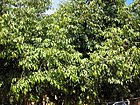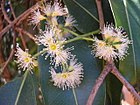Note: This is a project under development. The articles on this wiki are just being initiated and broadly incomplete. You can Help creating new pages.
Difference between revisions of "Syzygium cumini - Jambu, Malabar plum"
(→References) |
|||
| (6 intermediate revisions by the same user not shown) | |||
| Line 2: | Line 2: | ||
'''Syzygium cumini''' is an evergreen tropical tree in the flowering plant family Myrtaceae. Syzygium cumini is native to the Indian Subcontinent and adjoining regions of Southeast Asia. | '''Syzygium cumini''' is an evergreen tropical tree in the flowering plant family Myrtaceae. Syzygium cumini is native to the Indian Subcontinent and adjoining regions of Southeast Asia. | ||
==Uses== | ==Uses== | ||
| − | {{Uses|Diabetes}}, {{Uses|Dysentery}}, {{Uses|Snakebites}}, {{Uses|Hyperglycaemia}}, {{Uses|Glycosuria}}, {{Uses|Wounds}}, {{Uses|Irregular menstruation}}, {{Uses|Mouth ulcers}}, {{Uses|Diarrhoea}} | + | {{Uses|Diabetes}}, {{Uses|Dysentery}}, {{Uses|Snakebites}}, {{Uses|Hyperglycaemia}}, {{Uses|Glycosuria}}, {{Uses|Wounds}}, {{Uses|Irregular menstruation}}, {{Uses|Mouth ulcers}}, {{Uses|Diarrhoea}}. |
| + | |||
| + | ===Food=== | ||
| + | Syzygium cumini can be used in Food. Mature fruits are eaten raw.<ref name="Forest foods of Western Ghat"/> | ||
==Parts Used== | ==Parts Used== | ||
| Line 11: | Line 14: | ||
==Common names== | ==Common names== | ||
| − | {{Common names|kn=Jambunerale | + | {{Common names|kn=Jambunerale|ta=Nagai|hi=Jamun|en=Java plum, Jamun}} |
==Properties== | ==Properties== | ||
| Line 28: | Line 31: | ||
Kapha, Vata | Kapha, Vata | ||
===Prabhava=== | ===Prabhava=== | ||
| + | ===Nutritional components=== | ||
| + | Syzygium cumini Contains the Following nutritional components like - Ascorbic acid, acetic acid; thiamine, riboflavin, niacin, fructose and glucose carotene, vitamin A; folic acid, palmitic, stearic, oleic and linoleic, dextrin, phytosterol, tannin, β-sitosterol. corilagin, ellagitannins, ellagic acid, gal-loyl-galactoside and gallic acid; chlorine, copper, iron, Magnesium, nitrogen, phosphorus, Potassium, Sodium, sulfur<ref name="Forest foods of Western Ghat"/>. | ||
==Habit== | ==Habit== | ||
| Line 37: | Line 42: | ||
===Flower=== | ===Flower=== | ||
| − | {{Flower|Unisexual|2.5-10 cm| | + | {{Flower|Unisexual|2.5-10 cm|White, rose-pink|5-20|These are fragrant and appear in clusters 2.5-10 cm long, each being 1.25 cm wide and 2.5 cm long}} |
===Fruit=== | ===Fruit=== | ||
| − | {{Fruit| | + | {{Fruit|Oblong|1.25-5 cm long|The fruit is usually astringent, sometimes unpalatably so, and the flavour varies from acid to fairly sweet|With hooked hairs|2-5}} |
===Other features=== | ===Other features=== | ||
| Line 55: | Line 60: | ||
==How to plant/cultivate== | ==How to plant/cultivate== | ||
| − | A plant of the tropics and subtropics, where it is found at elevations up to 1500 metres. It grows best in areas where annual daytime temperatures are within the range 20 - 32°c, but can tolerate 12 - 48°c Seeds must be sown immediately after harvest, they germinate readily | + | A plant of the tropics and subtropics, where it is found at elevations up to 1500 metres. It grows best in areas where annual daytime temperatures are within the range 20 - 32°c, but can tolerate 12 - 48°c Seeds must be sown immediately after harvest, they germinate readily<ref name="How to plant/cultivate"/>. Syzygium cumini is available through March to June<ref name="Forest foods of Western Ghat"/>. |
==Commonly seen growing in areas== | ==Commonly seen growing in areas== | ||
| − | {{Commonly seen|Tropical areas}}, {{Commonly seen|Subtropical forest areas}}, {{Commonly seen| | + | {{Commonly seen|Tropical areas}}, {{Commonly seen|Subtropical forest areas}}, {{Commonly seen|Wet to fairly dry areas}}. |
==Photo Gallery== | ==Photo Gallery== | ||
<gallery class="left" caption="" widths="140px" heights="140px"> | <gallery class="left" caption="" widths="140px" heights="140px"> | ||
| − | |||
Image:Syzygium cumini Blanco1.174.png | Image:Syzygium cumini Blanco1.174.png | ||
Image:Syzygium cumini flowers.JPG | Image:Syzygium cumini flowers.JPG | ||
| Line 77: | Line 81: | ||
<references> | <references> | ||
| − | <ref name="chemical composition">[https://www.ncbi.nlm.nih.gov/pubmed/20836162 | + | <ref name="chemical composition">[https://www.ncbi.nlm.nih.gov/pubmed/20836162 Chemical constituents]</ref> |
| − | <ref name="Leaf">[http://ijpsr.com/bft-article/morphology-pytochemistry-and-pharmacology-of-syzygium-cumini-linn-an-overview/?view=fulltext | + | <ref name="Leaf">[http://ijpsr.com/bft-article/morphology-pytochemistry-and-pharmacology-of-syzygium-cumini-linn-an-overview/?view=fulltext Botanical Discription]</ref> |
| − | <ref name="Ayurvedic preparations">[https://easyayurveda.com/2013/01/29/jamun-benefits-usage-dose-side-effects-complete-ayurveda-details/ | + | <ref name="Ayurvedic preparations">[https://easyayurveda.com/2013/01/29/jamun-benefits-usage-dose-side-effects-complete-ayurveda-details/ Ayurvedic preparations]</ref> |
| − | <ref name="How to plant/cultivate">[http://tropical.theferns.info/viewtropical.php?id=Syzygium+cumini | + | <ref name="How to plant/cultivate">[http://tropical.theferns.info/viewtropical.php?id=Syzygium+cumini Cultivation Details]</ref> |
| + | <ref name="Forest foods of Western Ghat">"Forest food for Northern region of Western Ghats" by Dr. Mandar N. Datar and Dr. Anuradha S. Upadhye, Page No.145, Published by Maharashtra Association for the Cultivation of Science (MACS) Agharkar Research Institute, Gopal Ganesh Agarkar Road, Pune</ref> | ||
</references> | </references> | ||
Latest revision as of 09:38, 17 November 2021
Syzygium cumini is an evergreen tropical tree in the flowering plant family Myrtaceae. Syzygium cumini is native to the Indian Subcontinent and adjoining regions of Southeast Asia.
Contents
- 1 Uses
- 2 Parts Used
- 3 Chemical Composition
- 4 Common names
- 5 Properties
- 6 Habit
- 7 Identification
- 8 List of Ayurvedic medicine in which the herb is used
- 9 Where to get the saplings
- 10 Mode of Propagation
- 11 How to plant/cultivate
- 12 Commonly seen growing in areas
- 13 Photo Gallery
- 14 References
- 15 External Links
Uses
Diabetes, Dysentery, Snakebites, Hyperglycaemia, Glycosuria, Wounds, Irregular menstruation, Mouth ulcers, Diarrhoea.
Food
Syzygium cumini can be used in Food. Mature fruits are eaten raw.[1]
Parts Used
Chemical Composition
Total phenolics, anthocyanins and flavonoid contents of pulp, respectively. Kernel and seed coat contained total phenolics respectively.[2]
Common names
| Language | Common name |
|---|---|
| Kannada | Jambunerale |
| Hindi | Jamun |
| Malayalam | NA |
| Tamil | Nagai |
| Telugu | NA |
| Marathi | NA |
| Gujarathi | NA |
| Punjabi | NA |
| Kashmiri | NA |
| Sanskrit | NA |
| English | Java plum, Jamun |
Properties
Reference: Dravya - Substance, Rasa - Taste, Guna - Qualities, Veerya - Potency, Vipaka - Post-digesion effect, Karma - Pharmacological activity, Prabhava - Therepeutics.
Dravya
Rasa
Tikta (Bitter), Kashaya (Astringent)
Guna
Laghu (Light), Ruksha (Dry), Tikshna (Sharp)
Veerya
Ushna (Hot)
Vipaka
Katu (Pungent)
Karma
Kapha, Vata
Prabhava
Nutritional components
Syzygium cumini Contains the Following nutritional components like - Ascorbic acid, acetic acid; thiamine, riboflavin, niacin, fructose and glucose carotene, vitamin A; folic acid, palmitic, stearic, oleic and linoleic, dextrin, phytosterol, tannin, β-sitosterol. corilagin, ellagitannins, ellagic acid, gal-loyl-galactoside and gallic acid; chlorine, copper, iron, Magnesium, nitrogen, phosphorus, Potassium, Sodium, sulfur[1].
Habit
Identification
Leaf
| Kind | Shape | Feature |
|---|---|---|
| Simple | The leaves are turpentine smell, and are opposite, 5-25 cm long, 2.5-10 cm wide, oblong-oval or elliptic, blunt or tapering to a point at the apex |
Flower
| Type | Size | Color and composition | Stamen | More information |
|---|---|---|---|---|
| Unisexual | 2.5-10 cm | White, rose-pink | 5-20 | These are fragrant and appear in clusters 2.5-10 cm long, each being 1.25 cm wide and 2.5 cm long |
Fruit
| Type | Size | Mass | Appearance | Seeds | More information |
|---|---|---|---|---|---|
| Oblong | 1.25-5 cm long | The fruit is usually astringent, sometimes unpalatably so, and the flavour varies from acid to fairly sweet | With hooked hairs | 2-5 | {{{6}}} |
Other features
List of Ayurvedic medicine in which the herb is used
Where to get the saplings
Mode of Propagation
How to plant/cultivate
A plant of the tropics and subtropics, where it is found at elevations up to 1500 metres. It grows best in areas where annual daytime temperatures are within the range 20 - 32°c, but can tolerate 12 - 48°c Seeds must be sown immediately after harvest, they germinate readily[5]. Syzygium cumini is available through March to June[1].
Commonly seen growing in areas
Tropical areas, Subtropical forest areas, Wet to fairly dry areas.
Photo Gallery
References
- ↑ 1.0 1.1 1.2 "Forest food for Northern region of Western Ghats" by Dr. Mandar N. Datar and Dr. Anuradha S. Upadhye, Page No.145, Published by Maharashtra Association for the Cultivation of Science (MACS) Agharkar Research Institute, Gopal Ganesh Agarkar Road, Pune
- ↑ Chemical constituents
- ↑ Botanical Discription
- ↑ Ayurvedic preparations
- ↑ Cultivation Details
External Links
- Ayurvedic Herbs known to be helpful to treat Diabetes
- Ayurvedic Herbs known to be helpful to treat Dysentery
- Ayurvedic Herbs known to be helpful to treat Snakebites
- Ayurvedic Herbs known to be helpful to treat Hyperglycaemia
- Ayurvedic Herbs known to be helpful to treat Glycosuria
- Ayurvedic Herbs known to be helpful to treat Wounds
- Ayurvedic Herbs known to be helpful to treat Irregular menstruation
- Ayurvedic Herbs known to be helpful to treat Mouth ulcers
- Ayurvedic Herbs known to be helpful to treat Diarrhoea
- Herbs with Fruits used in medicine
- Herbs with common name in Kannada
- Herbs with common name in Hindi
- Herbs with common name in Tamil
- Herbs with common name in English
- Habit - Evergreen shrub
- Index of Plants which can be propagated by Seeds
- Index of Plants which can be propagated by Cuttings
- Herbs that are commonly seen in the region of Tropical areas
- Herbs that are commonly seen in the region of Subtropical forest areas
- Herbs that are commonly seen in the region of Wet to fairly dry areas
- Herbs
- Ayurvedic herbs that don't have seed photos
- Myrtaceae









